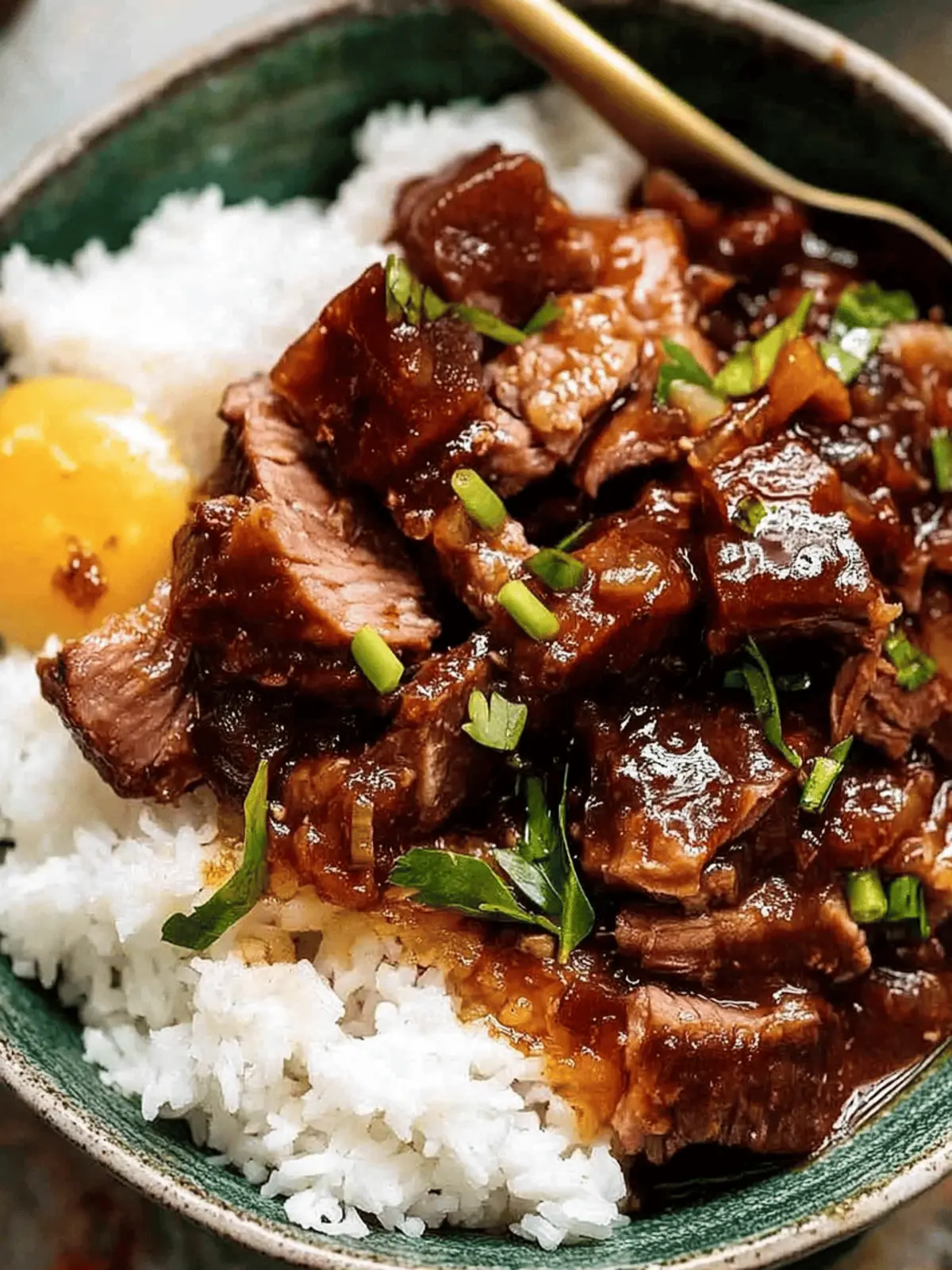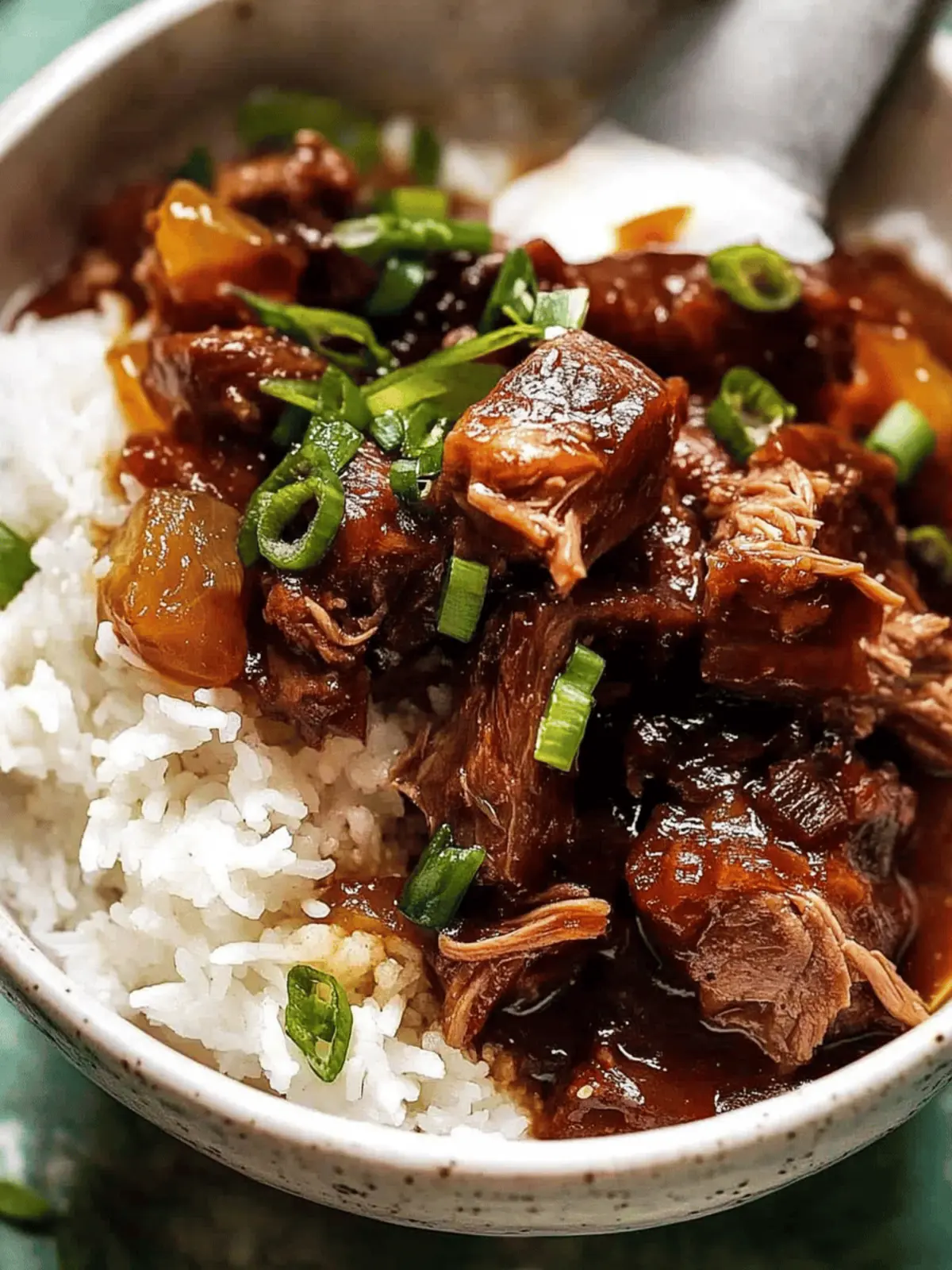When the craving for something savory and satisfying strikes, nothing compares to the comforting embrace of Filipino Pork Adobo. I first came across this delightful recipe during a potluck dinner, and it was a culinary revelation—tender pork simmered slowly in a rich soy-garlic sauce that clings to each delicious bite. It felt like an array of flavors dancing on my taste buds, each beckoning me for more.
With just a handful of pantry staples, this dish is easy to whip up and even easier to indulge in. The beauty of Pork Adobo lies not only in its mouthwatering taste but also in its versatility: whether you choose to feature perfectly caramelized pineapple for a hint of sweetness or stick to the classic savory profile, it promises to be a crowd-pleaser at your table. Served over fluffy jasmine rice, this recipe will transport you straight to the heart of the Philippines with every forkful. So, let’s dive into this culinary treasure that’s sure to transform your weeknight dinners!
Why is Filipino Pork Adobo a Must-Try?
Simplicity: This recipe requires minimal prep and basic cooking skills, perfect for any home cook.
Rich, Flavorful Sauce: The blend of soy sauce, garlic, and optional pineapple creates a deeply savory, sweet glaze that elevates the pork.
Tender Perfection: Slow cooking results in incredibly tender meat that falls apart with just a fork.
Versatile Dish: Customize your Pork Adobo by adding vegetables or even substituting chicken for a different twist.
Crowd-Pleasing: Serve this dish at gatherings, and watch your guests indulge in seconds—it’s loved by everyone!
Easy Make-Ahead: Preparing in advance allows the flavors to deepen, making it a great option for meal prep.
Filipino Pork Adobo Ingredients
For the Pork
- Pork Shoulder – Choose this main protein for its moisture and tenderness that transforms in slow cooking.
- Pineapple (optional) – Adds sweetness and freshness; using canned rings cut into pieces elevates the dish.
For the Sauce
- Vegetable Oil – Essential for searing the pork for rich flavor; any neutral oil can substitute.
- Onion – Sweetens the dish and deepens flavor when sautéed; slice into wedges for even cooking.
- Garlic – Infuses aromatic goodness into the sauce when sliced and cooked.
- Light Soy Sauce – Provides saltiness and umami; can swap with all-purpose soy sauce if preferred.
- Dark Soy Sauce – Delivers rich color and depth; use more light soy if needed.
- Rice Vinegar – Key for that tangy adobo flavor; regular white vinegar is a good alternative.
- Brown Sugar – Balances savory and tangy notes; try white sugar or honey if desired.
- Black Peppercorns – Adds a gentle heat; feel free to omit or use ground black pepper.
- Bay Leaves – Infuses a subtle herbal flavor; fresh is best, but dried works too.
- Water – Acts as the base for the braising liquid, ensuring flavor throughout the dish.
With these simple Filipino Pork Adobo ingredients, you’re on your way to creating a mouthwatering experience that will surely delight your taste buds!
How to Make Filipino Pork Adobo
-
Sear Pork: Heat vegetable oil in a large pot over high heat. Sear the pork shoulder in batches for about 4 minutes each until golden brown, then transfer to a bowl to keep warm.
-
Sauté Aromatics: Reduce the heat and add the onion, sautéing for 2 minutes until it becomes translucent. Add the sliced garlic, cooking for another minute until fragrant and soft.
-
Prepare Braising Liquid: In the same pot, combine water, light soy sauce, dark soy sauce, rice vinegar, brown sugar, black peppercorns, and bay leaves. Stir it all together before returning the seared pork to the pot.
-
Slow Cook: Bring the mixture to a boil, then lower the heat to a gentle simmer, partially covering. Allow it to cook for 1.5 hours, until the pork is tender and can be easily shredded with a fork.
-
Caramelize Pineapple: In a non-stick pan, heat a little oil over medium heat. Sauté pineapple pieces until they are golden brown, about 4 minutes on each side, and set aside.
-
Reduce Sauce: After removing the pork, bring the sauce back to a boil and reduce it vigorously to about 1.5 cups, which should take around 8 minutes.
-
Combine and Serve: Reintroduce the pork and caramelized pineapple into the reduced sauce. Warm everything through and serve it over fluffy jasmine rice, garnishing with sliced green onion for a fresh touch.
Optional: Garnish with chopped cilantro for added freshness.
Exact quantities are listed in the recipe card below.
Storage Tips for Filipino Pork Adobo
Fridge: Keep your leftover Filipino Pork Adobo in an airtight container for up to 4 days to preserve its delightful flavors.
Freezer: For longer storage, freeze your Pork Adobo in a freezer-safe container for up to 3 months. Make sure to cool it completely before freezing to maintain texture.
Reheating: When ready to enjoy again, thaw overnight in the fridge. Reheat gently on the stovetop over low heat, adding a splash of water or soy sauce if needed to retain moisture.
Serving Suggestions: Leftovers taste even better the next day as the flavors deepen. Pair with fresh jasmine rice for a hearty meal!
Filipino Pork Adobo Variations
Feel free to let your creativity shine and customize this dish to suit your taste and dietary needs.
-
Chicken Adobo: Swap pork for chicken thighs or drumsticks for a lighter twist that’s equally satisfying.
Chicken adapts beautifully to the adobo sauce, absorbing flavors and yielding moist results. -
Vegetarian Delight: Substitute the meat with hearty vegetables like eggplant, mushrooms, and zucchini for a vibrant plant-based option.
The robust sauce will enhance the natural sweetness of the vegetables, resulting in a savory medley. -
Add Carrots or Potatoes: Toss in chunks of carrots or potatoes for extra heartiness and a sweet undertone.
These starchy additions will soak up the sauce, making each bite even more comforting. -
Sweet and Spicy: Incorporate sliced jalapeños or a dash of chili flakes to add a pleasing kick to the dish.
This combination of sweet, savory, and spicy will create layers of flavor that excite the palate. -
Herbed Variation: Include fresh herbs like cilantro or bay leaves to brighten the overall taste of the dish.
Herbs infuse freshness, bringing a new dimension to the rich flavors of the adobo. -
Coconut Cream Twist: Stir in coconut cream near the end of cooking for a luscious, creamy texture and a tropical hint.
This will add a luxurious richness while complementing the tangy sauce beautifully. -
Increase the Sweetness: If you prefer a sweeter profile, add more brown sugar or include an extra slice of caramelized pineapple.
A touch of added sweetness balances the savory notes, making it a crowd-pleaser for sweet tooth lovers. -
Soy Sauce Alternatives: For a gluten-free version, opt for tamari instead of soy sauce while still preserving that deep umami flavor.
This simple swap maintains the dish’s authenticity while catering to dietary restrictions.
What to Serve with Filipino Pork Adobo?
To create a truly satisfying meal, you’ll want to balance the rich flavors of the Pork Adobo with some enticing sides.
-
Fluffy Jasmine Rice: A classic companion, it perfectly soaks up the savory soy-garlic sauce, making every bite a delight.
-
Cucumber Salad: This fresh, crunchy side adds brightness to your plate, contrasting beautifully with the tender pork and luscious glaze.
-
Steamed Green Beans: Their vibrant color and crisp texture provide a great contrast, while lightly tossed with garlic to echo the flavors of the adobo.
-
Pineapple Fried Rice: Combine leftover rice with sautéed pineapple bits for a sweet-savory side that complements the dish’s overall flavor profile.
-
Garlic Naan Bread: For a fun twist, serve with this soft, aromatic bread that is perfect for scooping up the thickened sauce.
-
Coconut Flan: If you’re feeling indulgent, this smooth, creamy dessert is the perfect sweet note to finish your meal on a high.
These pairings not only elevate your dining experience but also create a heartwarming feast for family and friends alike!
Make Ahead Options
These Filipino Pork Adobo are an ideal choice for busy home cooks who want to save time without sacrificing flavor! You can sear the pork, sauté the aromatics, and prepare the braising liquid up to 24 hours in advance—just refrigerate everything in an airtight container. When ready to cook, simply return the pork to the pot, bring it to a boil, and simmer it gently as directed. Additionally, caramelizing the pineapple can also be done ahead and stored separately for a quick finish. To maintain the quality, ensure the cooked components are stored properly, and remember that the flavors deepen as they sit, making your Pork Adobo just as delicious, if not better, when reheated!
Expert Tips for Filipino Pork Adobo
-
Sear for Flavor: Make sure to sear the pork until golden brown. This step locks in deep flavors that enhance the entire dish.
-
Gentle Simmer: Avoid boiling; maintain a gentle simmer to achieve fork-tender pork. Rapid boiling can toughen the meat.
-
Skip the Slow Cooker: Use a pot instead of a slow cooker to take advantage of the caramelization that enhances the Filipino Pork Adobo’s flavor profile.
-
Taste as You Go: Adjust the vinegar according to your taste preferences. A little more or less can make a big difference in the tangy balance.
-
Don’t Rush Sauce Reduction: Allow the sauce to reduce adequately. This thickening process ensures a rich, flavorful glaze that clings beautifully to the pork.
Filipino Pork Adobo Recipe FAQs
What type of pork is best for Filipino Pork Adobo?
I recommend using pork shoulder because it contains a good amount of fat, which renders down during cooking, making the meat incredibly tender and juicy. If you’re looking for a richer flavor, pork belly is also a great option, but it will be fattier, so adjust accordingly.
How do I store leftover Pork Adobo?
Leftover Filipino Pork Adobo can be stored in an airtight container in the fridge for up to 4 days. Make sure it’s completely cooled before sealing the container to help maintain freshness. Trust me, the flavors will actually deepen the longer it sits!
Can I freeze Filipino Pork Adobo?
Absolutely! You can freeze your Pork Adobo in a freezer-safe container for up to 3 months. To freeze it, allow it to cool completely, then portion it out if you prefer. When ready to enjoy, thaw it overnight in the fridge before reheating gently on the stovetop over low heat, adding a splash of water if necessary to keep it moist.
What should I do if the sauce is too salty?
If you find the sauce is too salty after cooking, don’t worry! You can dilute the flavor by adding a bit of water or low-sodium chicken broth, then simmer it for an additional 5-10 minutes. You can also add some sugar or increase the pineapple for a subtle balance!
Is Pork Adobo suitable for my gluten-free diet?
Yes, Filipino Pork Adobo can easily be made gluten-free! Just substitute the regular soy sauce with gluten-free soy sauce or tamari. This way, you can still enjoy that delicious umami flavor without compromising your dietary needs.
Can I use a slow cooker for this recipe?
I wouldn’t recommend a slow cooker for Filipino Pork Adobo. The dish benefits from the initial searing of the pork and the simmering in a pot, which creates a depth of flavor that a slow cooker may not achieve. Stick with the stovetop method for the best results!

Filipino Pork Adobo: Savory Comfort Food Made Easy
Ingredients
Equipment
Method
- Heat vegetable oil in a large pot over high heat. Sear the pork shoulder in batches for about 4 minutes each until golden brown, then transfer to a bowl to keep warm.
- Reduce the heat and add the onion, sautéing for 2 minutes until it becomes translucent. Add the sliced garlic, cooking for another minute until fragrant and soft.
- In the same pot, combine water, light soy sauce, dark soy sauce, rice vinegar, brown sugar, black peppercorns, and bay leaves. Stir it all together before returning the seared pork to the pot.
- Bring the mixture to a boil, then lower the heat to a gentle simmer, partially covering. Allow it to cook for 1.5 hours, until the pork is tender and can be easily shredded with a fork.
- In a non-stick pan, heat a little oil over medium heat. Sauté pineapple pieces until they are golden brown, about 4 minutes on each side, and set aside.
- After removing the pork, bring the sauce back to a boil and reduce it vigorously to about 1.5 cups, which should take around 8 minutes.
- Reintroduce the pork and caramelized pineapple into the reduced sauce. Warm everything through and serve it over fluffy jasmine rice, garnishing with sliced green onion for a fresh touch.



